Preface
Goal: Dynamically showing live data in terminal user interface using Python Rich Library from textualize.
This is the data model. We are going to wrapped the example data in a class.
Requirement
Fake Data
For demo purpose, we need these stuff:
- Displayed in table, with a few additional text message
- Number of row changed, dynamically.
- Number of row can’t be too few.
- Value changed, from time to time.
Example Case
I’m going to use months data as row header. From January to December, but shown dynamically. Only month with data will be shown, other will be hidden.
For each month I have these columns:
- Budget
- Actual
- Gap Difference
3: Data Modelling: Simple
Month Only
Python Source Code
A class along with instantiation, bundled in one file.
Class: Skeleton
Since we are going to utilize this class from outside, We need to care a bit about method visibility.
Here is in this class.
- One
MONTHSconstant property, - one constructor
- Two private method
- One public method (main)
class MonthData:
MONTHS = {...}
def __init__(self):
def __get_month_rnd(self):
def __get_months_dict(self):
def main(self):The months data is simply a dictionary:
MONTHS = {
1: 'January', 2: 'February',
3: 'March', 4: 'April',
5: 'May', 6: 'June',
7: 'July', 8: 'August',
9: 'September', 10: 'October',
11: 'November', 12: 'December'}And we will call the main method as below:
month_data = MonthData()
month_data.main()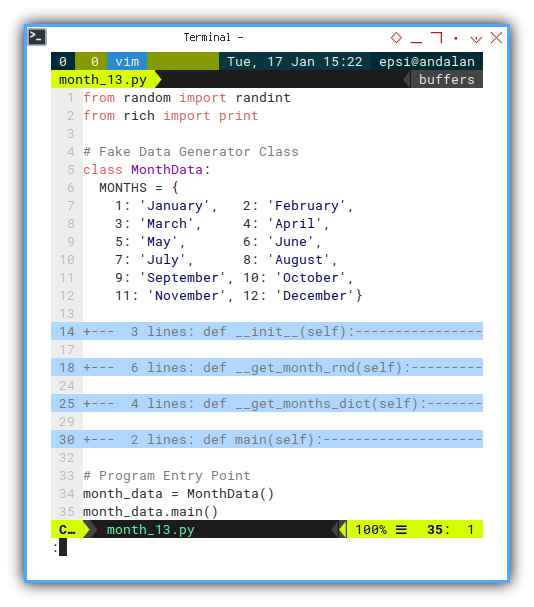
Constructor
This is the method actually called, when we create class instance.
We have two main properties:
- start month
- end month
For example 5, 9,
means may to september
def __init__(self):
# save initial parameter
[self.start, self.end] = self.__get_month_rnd()This will call private method __get_month_rnd().
Private Method
For internal use only
Private method only available in class only. And can’t be called from outside class.
Here we can set start and end,
using random number.
We are going to constraint number of row,
not to be too few. At least 4 month rows.
We measure this by using end - start > 3:.
def __get_month_rnd(self):
while True:
start = randint(1, 12)
end = randint(start, 12)
if end - start > 3: break
return [start, end]And also we can get the month name.
def __get_months_dict(self):
m_all = list(self.MONTHS.items())
m_slice = m_all[self.start:self.end]
return dict(m_slice)Public Method
Public method can be accessed from outside class.
def main(self):
print(self.__get_months_dict())Such as
month_data = MonthData()
month_data.main()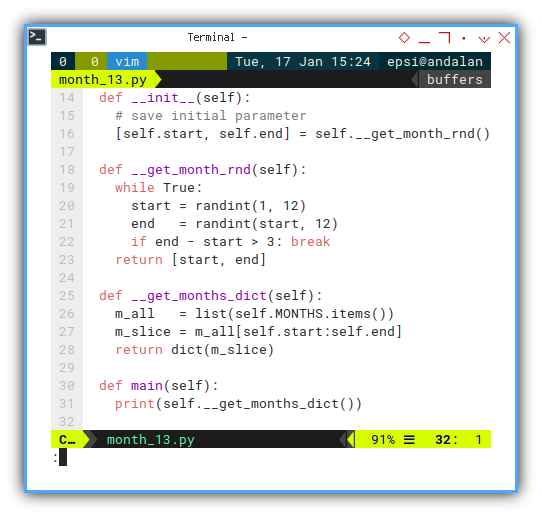
Example Output in CLI
The result of this function is similar as below:
❯ python month_13.py{4: 'April', 5: 'May', 6: 'June', 7: 'July'}
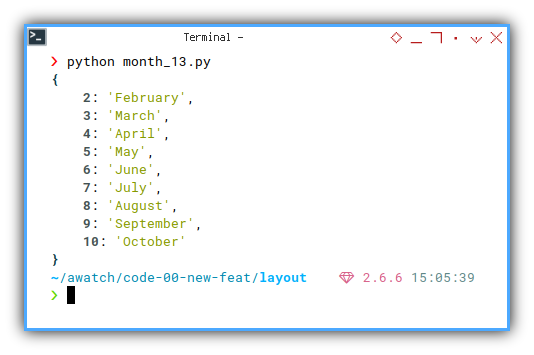
4: Data Modelling: Record Detail
With Budgeting
We are going to add these record structure:
- Budget
- Actual
- Gap Difference
Python Source Code
A class along with running part (instantiation), bundled in one file.
Class: Skeleton
class MonthData:
MONTHS = {...}
def __init__(self, baseline):
def __get_indices(self):
def __get_month_rnd(self):
def __get_months_dict(self):
def __init_random(self):
def __init_fakes(self):
def main(self):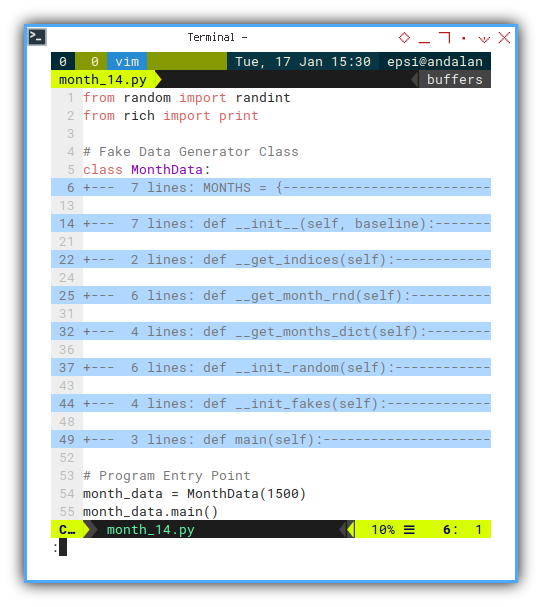
Main Script
We start with import.
from random import randint
from rich import printAnd we will call the main method as below:
month_data = MonthData(1500)
month_data.main()Note that we have one argument. Our budget base.
Constructor
We change a bit.
def __init__(self, baseline):
# save initial parameter
self.baseline = baseline
# build initial data
[self.start, self.end] = self.__get_month_rnd()
self.__init_fakes()
def __get_indices(self):
return list(range(self.start, self.end+1))Helper Method
Since we are going to refer to index many time, this small helper would help
def __get_indices(self):
return list(range(self.start, self.end+1))There is nothing new with these two method.
def __get_month_rnd(self):
def __get_months_dict(self):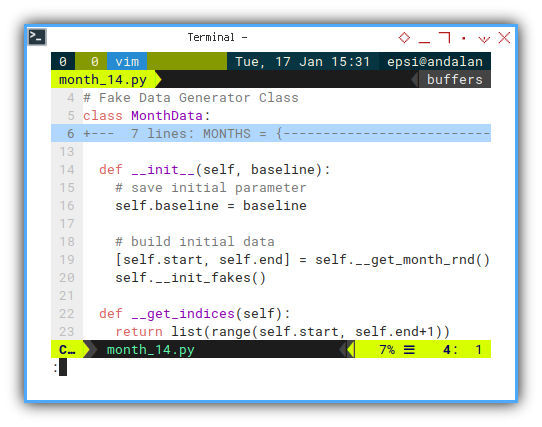
Method: Faking Data
Simulate budget randomly
Just these two functions.
We iterate for each indices,
and get the random data using __init_random()
def __init_fakes(self):
self.fakes = {}
for key in self.__get_indices():
self.fakes[key] = self.__init_random()While the function in detail is as simple as below:
- Budget: random data.
- Actual: random data.
- Gap Difference: based on calculation.
def __init_random(self):
budget = self.baseline + randint(-20, 100)
actual = self.baseline + randint(-50, 10)
gap = budget - actual
return [budget, actual, gap]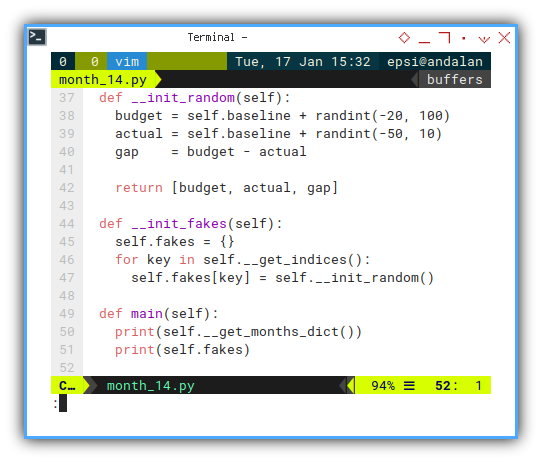
We put the data in self.fakes.
Class Instance
Finally we create instance, along with variable initialization, and call the main method.
class MonthData:
...
def main(self):
print(self.__get_months_dict())
print(self.fakes)
# Program Entry Point
month_data = MonthData(1500)
month_data.main()Example Output in CLI
Consider examine the data.
❯ python month_14.py{
2: 'February',
3: 'March',
4: 'April',
5: 'May',
6: 'June',
7: 'July',
8: 'August',
9: 'September',
10: 'October',
11: 'November'
}
{
2: [1494, 1497, -3],
3: [1508, 1450, 58],
4: [1531, 1470, 61],
5: [1522, 1497, 25],
6: [1572, 1473, 99],
7: [1587, 1497, 90],
8: [1548, 1459, 89],
9: [1585, 1486, 99],
10: [1586, 1510, 76],
11: [1525, 1487, 38]
}
Since we are using random data, the result would be different from time to time.
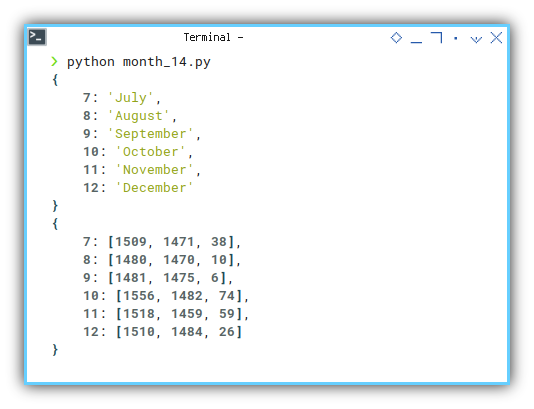
Both dictionary output looks like a JSON data.
Since I use this print method form rich,
The result looks pretty.
from rich import printIn the next section we are going to reproduce data dynamically.
5: Data Modelling: Dynamic
Change based on previous data
Why dynamically reproduce fake data? Because we are going to make nice rich demo. So this could looks like data captured from somewhere.
The rich demo should show capability, of rich table to add or remove row, from time to time, continuously.
Python Source Code
Since we are going to reus the class in our main script, we should separate the class and the running part.
Class: Skeleton
We have a bunch of new methods here.
from random import randint
# Fake Data Generator Class
class MonthData:
MONTHS = {...}
def __init__(self, baseline):
def __get_indices(self):
def __get_month_rnd(self):
def __update_month_rnd(self):
def __get_months_dict(self):
def __init_random(self):
def __init_fakes(self):
def __update_fakes(self):
def __update_fakes_value(self):
def get_strings(self):
def update(self):Though this looks scary. Don’t be intimidated by these bunch of method.
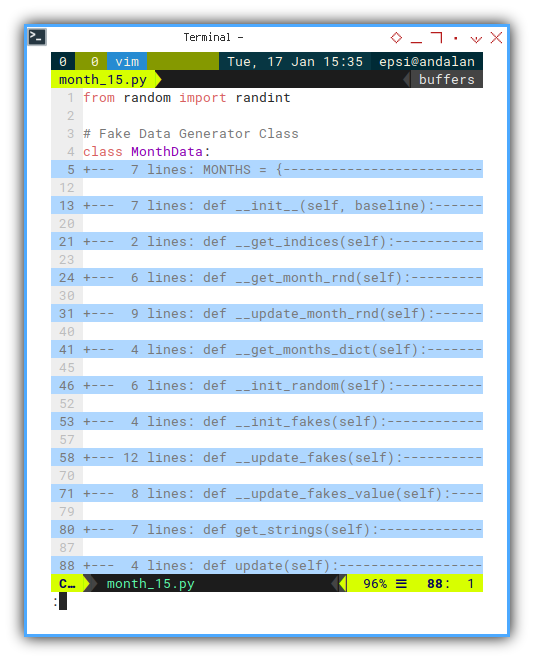
Most of the methods below is the same as previous. There is nothing change for these methods.
def __init__(self, baseline):
def __get_indices(self):
def __get_month_rnd(self):
def __get_months_dict(self):
def __init_random(self):
def __init_fakes(self):Method: Update Month Rows
Month row can’t be less than than three rows. If it less, start the loop.
def __update_month_rnd(self):
while True:
[start, end] = [self.start, self.end]
if randint(0, 1):
start += randint(-1, 1)
if start < 1: start = 1
else:
end += randint(-1, 1)
if end > 12: end = 12
if end - start > 3:
break
[self.start, self.end] = [start, end]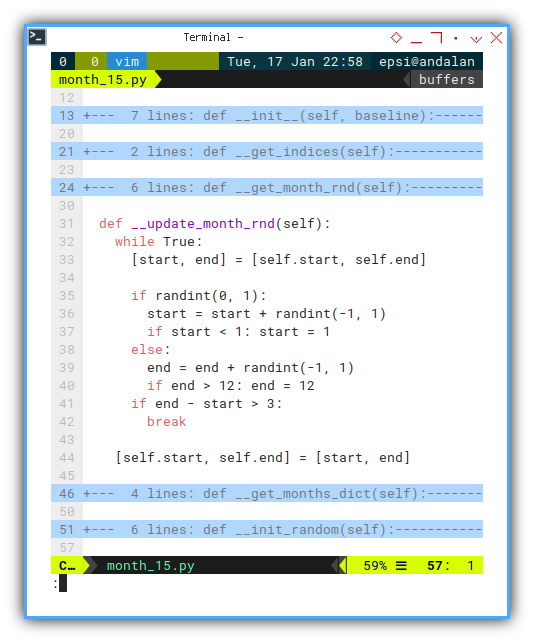
To make the animation looks smooth,
we only add/remove one row at a time.
We have to choose,
whether changing the head start, or the tail end.
if randint(0, 1):
start += ...
else:
end += ...
if end - start > 3:To prevent infinite loop,
the start and end data only be saved, if the data valid.
This is why we have these notation:
def __update_month_rnd(self):
while True:
[start, end] = [self.start, self.end]
...
[self.start, self.end] = [start, end]Method: Update Months
Add/Remove rows of months
After we got a new key,
we must also update the data in self.fakes.
In order to do this, we should compare
current head start and tail end,
with obsolete self fakes.
Removing unwanted key,
and repopulate new key with random data.
def __update_fakes(self):
# remove key
unwanted = set(self.fakes.keys()) \
- set(self.__get_indices())
for key in unwanted:
self.fakes.pop(key, None)
# add key
wanted = set(self.__get_indices()) \
- set(self.fakes.keys())
for key in wanted:
self.fakes[key] = self.__init_random()Method: Go further with details
We can also change the detail a bit for finishing touch.
- Budget: remain the same.
- Actual: add/substract with random fluctuation.
- Gap Difference: based on calculation.
def __update_fakes_value(self):
for key in self.__get_indices():
[budget, actual, gap] = self.fakes[key]
actual = actual + randint(-10, 10)
gap = budget - actual
self.fakes[key] = [budget, actual, gap]
Public Method
First we update the data by correct order
def update(self):
self.__update_month_rnd()
self.__update_fakes()
self.__update_fakes_value()Then get the record as string value, to be feed to rich panel.
We have to rebuild the structure, to suit our need. Such as, convert all item to string, because rich panel only accept string value.
def get_strings(self):
rows = {}
for key in self.__get_indices():
[budget, actual, gap] = self.fakes[key]
rows[key] = [self.MONTHS[key],
str(budget), str(actual), str(gap)]
return rowsNote that you can also combine these function above, into just one function with return value.
After all this is just an example.
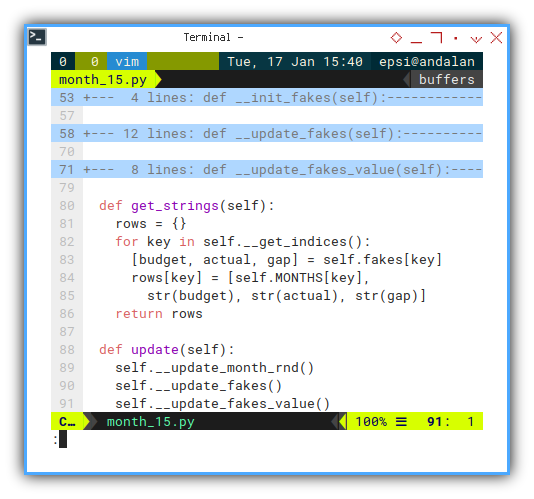
Run
From separate python script
We can import our class, and use it in our script.
import month_15
from rich import print
# Program Entry Point
month_data = month_15.MonthData(1300)
print(month_data.get_strings())
for c in range(1, 5+1):
month_data.update()
print(month_data.get_strings())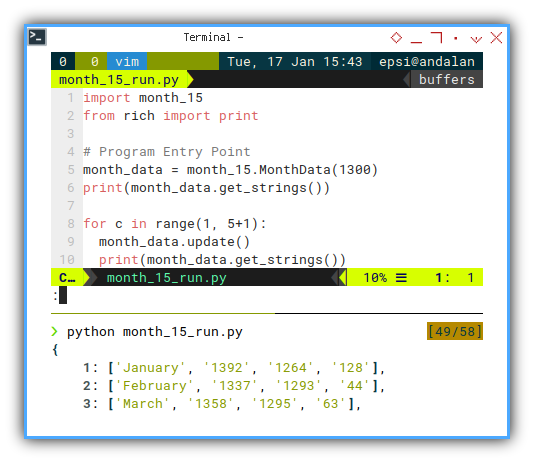
Output in CLI
The result of this function is similar as below:
❯ python month_15_run.py{
6: ['June', '1342', '1305', '37'],
7: ['July', '1312', '1267', '45'],
8: ['August', '1289', '1279', '10'],
9: ['September', '1320', '1279', '41'],
10: ['October', '1294', '1255', '39'],
11: ['November', '1345', '1286', '59']
}
{
5: ['May', '1357', '1307', '50'],
6: ['June', '1342', '1297', '45'],
7: ['July', '1312', '1262', '50'],
8: ['August', '1289', '1275', '14'],
9: ['September', '1320', '1278', '42'],
10: ['October', '1294', '1253', '41'],
11: ['November', '1345', '1294', '51']
}
With number of month might changed from time to time continuosly.
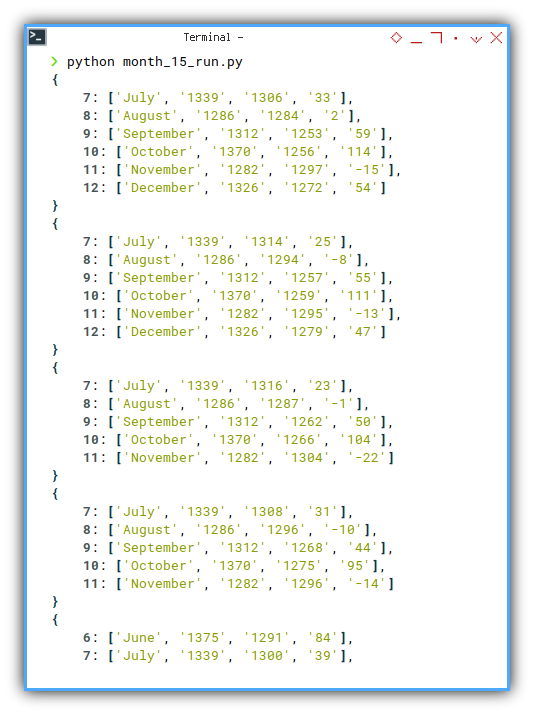
We are done with data modelling.
What is Next 🤔?
Enough data example
I can’t wait to apply the data to rich Panel.
Consider continue reading [ Python - Rich - Live Asynchronous ].